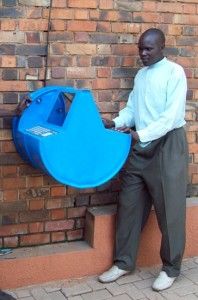Learning Urban Design From Developing Countries
A design exhibition brings innovative solutions to urban communities around the world
/https://tf-cmsv2-smithsonianmag-media.s3.amazonaws.com/filer/20111026023004medillin-hillside-small.jpg)
For decades, in Medellín, Columbia, the difference between rich and poor areas has been a virtual tale of two cities. “The formal city grew in the valley, and the informal settlement on the hills around. It was the most violent city in the world” says Cynthia E. Smith, a curator of socially responsible design at the Smithsonian Cooper-Hewitt, National Design Museum, in New York City.
Then, the city embarked on a large-scale project to tie the two areas together, building a cable mass transit system up the hillsides and surrounding the stations with parks. “The mayor said ‘I want to build the most beautiful buildings in the poorest parts of the city,’ and so he built worldclass libraries and business centers next to the parks,” Smith says. Over time, violence in the outlying areas of the cities dropped sharply and land values rose.
Medellín is one of dozens of success stories, large and small, that fill the newly opened “Design with the Other 90%: Cities” exhibition at the United Nations Building in New York. On Manhattan’s East Side, among skyscrapers and luxury hotels in one of the wealthiest cities on the planet, the exhibition showcases how the world’s most destitute countries have solved integral problems of housing, health care, infrastructure and the environment. Through multimedia, scale models, maps and prototypes, the show illustrates to visitors the worries of daily life in the squatter communities of countries like India, Uganda and Mexico—as well as the potential for design to provide solutions.
In recent years, urbanization and population growth in developing countries have caused countless problems in cities across Asia, Africa and South America to escalate. “Close to one billion people live in informal settlements, more commonly known as slums or squatter communities, and that’s projected to grow to two billion over the next 20 years,” Smith says. “Many municipalities and regional governments can’t keep up with this rapid growth, and so there’s an exchange that’s taking place between the informal communities and designers, architects, urban planners and engineers.”
“The show is specifically design ‘with,’” she says. “It’s really about working in partnership with people in the informal settlements, exchanging design information so that they can build their own, better housing.”
The show features 60 novel design approaches that have been applied to problems as varied as transferring money to relatives (using a mobile phone based system) and charging devices without an electrical grid (running a bicycle wheel to create an electrical current).

They also range from the ingeniously obvious to the remarkably intricate. In Bangladesh, arsenic is the most common toxin in drinking water, and in severe cases can cause death. Abul Hussam, a chemist at George Mason University designed the SONO Water Filter to address this problem as simply and inexpensively as possible. “It’s a sand and composite iron matrix, and wood charcoal, and brick chips,” says Smith. “You just pour in the water, and it filters through, and you end up without toxins.”
In Uganda, meanwhile, researchers found an information gap: only 3 percent of Ugandan adults typically use the internet, compared to 15 percent in neighboring Kenya. A UNICEF team created the Digital Drum, a freestanding solar-powered computing hub. “They work locally with car mechanics to build them,” Smith says, using discarded oil drums to enclose rugged computers equipped with basic software. “They provide some very basic information about rights and safety, health, education, and there are games on here that the kids can play to teach them about math.”
In designing the exhibition, which updates the original 2007 Cooper-Hewitt “Design with the Other 90%” show, Smith traveled the world and consulted with an international panel to select the range of projects shown. Along with the exhibition and the website, Smith says, “We have a new ‘Design with the Other 90%’ network, which is a social network linked to the website, where designers can upload their own projects.”
Along with the show’s backers, which include the UN Academic Impact Initiative, Smith hopes to use this network—and the exhibition’s placement at the UN—to spark further innovation and collaboration among the international design community. “Because this growth is happening so quickly, you can look at it as one billion problems, or one billion solutions,” she says.
Wandering the rows of innovations on display, ones sees that the point of “Design with the Other 90%” is not that solutions are immediate or easy. It’s made clear, through graphics and data, that the developing world’s problems are growing exponentially. But the exhibition is uplifting; despite seemingly daunting circumstances, design can put relief within reach—and the movement to employ it in slums and squatter communities is growing.
The Cooper-Hewitt National Design Museum’s “Design with the Other 90%: Cities” is on display at the UN Building in New York City through January 9, 2012.
/https://tf-cmsv2-smithsonianmag-media.s3.amazonaws.com/accounts/headshot/joseph-stromberg-240.jpg)
/https://tf-cmsv2-smithsonianmag-media.s3.amazonaws.com/accounts/headshot/joseph-stromberg-240.jpg)